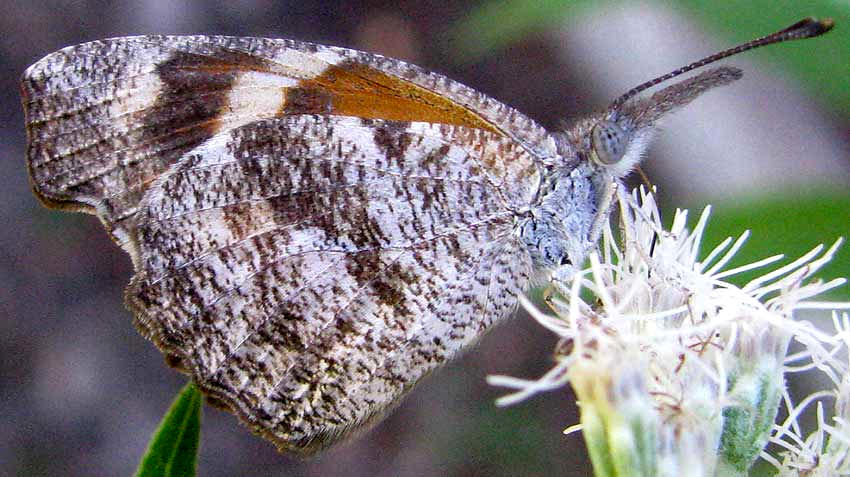Excerpts from Jim Conrad's
Naturalist Newsletter

from the November 18, 2012 Newsletter issued from the valley of the Dry Frio River in northern Uvalde County, southwestern Texas, on the southern border of the Edwards Plateau; elevation ~1750m (~5750 ft); N29.62°, W99.86°; USA
SNOUT BUTTERFLIES
Following the trail down to the little Dry Frio River behind the cabin suddenly I realized I was inside a cloud of butterflies. They were all over and in and out of a Netleaf Hackberry tree, still prettily bearing this year's crop of sweet but big-seeded red fruits, and nowhere else. I couldn't see that the butterflies were doing anything there such as laying eggs. They seemed to just like flitting in and out of that tree.
The butterfly species mobbing the hackberry was one of our easiest to identify because of what appears to be its very long, pointy head, as you can see in the picture above.
That's an American Snout, LIBYTHEANA CARINENTA, distributed from Argentina north through Mexico and the Caribbean area into all of the southern US, from central California, Colorado and most of the eastern US. And it makes sense for American Snouts to be congregating in a hackberry tree on a sunny afternoon in mid November in southwestern Texas, for the species' caterpillars feed on various hackberry species -- species of the genus Celtis. My cloud of Snouts must have been making babies there when I wasn't looking.
What looks like a pointy head or a snout on the butterfly actually are unusually large and extended "labial palps," which are mustache-like mouthparts covered with sensory hairs and scales. Other butterfly species have labial palps, too, just not so conspicuous. Hairs on a butterfly's palps are sensitive to touch and other stimuli. Basically they help the insect figure out what's good food and what's not.
These enormous labial palps help define the Snout Butterfly Subfamily, the Libytheinae, consisting of two genera and about ten species. Our American Snout is the only member of the family found in North America.
Upon my arrival here I was told of occasional mass migrations of this species, whole clouds of them so thick that if you're driving through them you have to constantly stop to wipe off your windshield. This fall I've seen only one movement of the species that looked like a migration, but it wasn't really cloudlike -- just many widely spaced Snout Butterflies all flying the same direction.
from the April 28, 2002 Newsletter issued from the woods a few miles south of Natchez, Mississippi, USA
SNOUT BUTTERFLY EXPLOSIONS
Tuesday afternoon as I stepped from my trailer door I almost fell because on the ground exactly where I intended to place my foot there sat several Snout Butterflies. I managed to sort of leap over them, plus they scattered, so no one got hurt.
Of all the places they could have gathered, why had they chosen that specific spot? Then I noticed that half a dozen other Snout Butterflies were gathered on the rolled-up bandana I use each morning as a sweatband when I jog.
Of course, that was it. The Snout Butterflies wanted the salt from my sweat. When I rise from the computer after working I'm so close to the door that the first contact the sole of my left foot makes with anyplace is that precise spot on the ground outside my door. It's hot in my trailer and my feet sweat, so the butterflies get sweat-salts deposited by my left foot!
What a powerful need for salt we animals have. Hunters leave salt blocks all through the forest here for deer, and tracks show that the deer cherish them. Letters of early settlers describe enormous migrations of buffalo and other animals to places where salt was available -- to salt licks. Ancient humans, too, valued salt. In Mexico's Yucatan Peninsula for a long time people wondered why such a magnificent ruin as that at Chichén Itzá should be located where there's not enough rain to support decent agriculture. It's now becoming apparent that Chichén Itzá controlled the salt trade along the Yucatan coast. Inland Indian nations paid dearly for that salt. Salt to the Yucatan Maya was like oil to the Middle East's Arabs today. To much of nature, sweating humans are walking salt mines.
For, the salts lost in sweat contain mineral elements without which life can't exist -- sodium, potassium, magnesium, calcium, and more. Without sodium and potassium, nerve impulses would not travel through an animal's nervous system. An atom of magnesium resides in the heart of every atom of chlorophyll, so photosynthesis in green plants would not be possible without magnesium. Bones are impossible without calcium.
Yet the Earth ecosystem is organized so that these mineral elements, which are soluble in water, simply flow to the sea when not in use by an organism or when not locked in minerals or soil organic matter. Why must these necessary elements be so vulnerable to leaching from our soils? This is majestic irony built into the Earth ecosystem. It's one of those circumstances assuring that us living things always have something to do, continually trying to get and keep what we need. Maybe this is another of those God jokes.
I stood there looking at the Snout Butterflies on my sweatband and I was gratified to know that at least something of what I produce in this life makes a few butterflies happy before eventually, inevitably, it flows to the Great Beyond.
These Snout Butterflies are remarkable-looking creatures, with noses shaped like those of SST jets. Their larvae feed on Sugarberry trees in our area, Hackberries farther north.